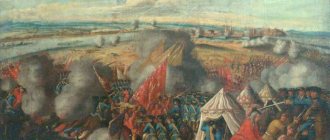The sage avoids all extremes.
Lao Tzu
The Azov campaigns began in 1695, when Peter 1 began military campaigns against the Turkish-Tatar fortress of Azov, which was located at the mouth of the Don River and was an important sea port of Azov. The young tsar set out to lead Russia to the sea. After the first campaign failed, Peter did not hesitate and within half a year began the second campaign. This time everything went well for Russia: for the first time, the country gained access to the ice-free Sea of Azov. However, further advance to the Black Sea required a full-fledged war with the then powerful Ottoman Empire, so Peter 1 began to prepare for a new, Northern War with Sweden. The article is devoted to a description of the causes, course and results of the Azov campaigns, as well as an analysis of assessments of the Azov campaigns by famous historians.
Azov was captured by Peter's army on July 18, 1696.
Prerequisites for the Azov campaigns
In 1689, the official reign of Peter 1 began. The young tsar saw one of his main tasks as ensuring Russia's access to the sea. Firstly, to create a powerful fleet, and secondly, to develop trade and ensure cultural ties. There were two options: the Baltic and the Black Sea. The first option required wars with Sweden and the Polish-Lithuanian Commonwealth. The second is with the Crimean Khanate and the Ottoman Empire. After the signing of the “Eternal Peace” with the Polish-Lithuanian Commonwealth in 1686, the Muscovite kingdom not only established friendly relations with its western neighbor, but also began to join the anti-Turkish coalition in Europe. As a result, the Crimean campaigns began (1687, 1689), which, however, did not bring success to Russia. However, the wars of the Turkish army in Europe, as well as the powerful alliance of Poland, Austria and the Republic of Venice against Turkey, significantly weakened the Ottoman Porte.
Russian-Turkish conflicts
Since the conquest of Crimea by Turkey in 1475, Russian-Turkish relations have remained quite tense for several centuries.
In the second half of the 17th century, Turkey, in addition to conquering Podolia from the Polish-Lithuanian Commonwealth and the island of Crete from Venice, tried to take possession of Right Bank Ukraine. This was met with opposition, and as a result of the Chigirin campaigns (1677, 1681), Russian and Ukrainian Cossack troops completely thwarted the capture attempts.
As a result, a truce agreement was signed in Bakhchisarai between Russia, Turkey and the Crimean Khanate (Treaty of Bakhchisarai, 1681). This was of great international importance.
However, the terms of the Bakhchisaray Agreement were annulled when the “Eternal Peace” was signed with Poland, which ended the Russian-Polish war, but obliged the Russian kingdom to resume military campaigns against the Crimean Khanate.
In 1687 and 1689, under the command of Queen Sophia’s favorite, Prince V. Golitsyn, two campaigns were undertaken against the Crimea and Turkey, which were never successful. Then it was obvious that Russia did not have sufficient potential for victory.
Reasons, goals and objectives of the parties
After Peter came to power, he decided to continue the previous direction of foreign policy, citing the possible weakening of Turkish-Tatar power. However, the Turkish-Tatar fortress of Azov was chosen as a new target. Peter literally raved about the sea, so the Azov campaigns were only a matter of time.
The main tasks of Russia during the Azov campaigns were:
- The assault and capture of the Azov fortress to provide a bridgehead with which to begin the struggle for access to the Black Sea.
- Transform the Azov sea fortress into a center for the creation of the Russian fleet.
- Establishing control over the territory of the Don River, which made it possible to develop a fleet in other cities on the Don, and, if necessary, lower them to the Sea of Azov.
- Weakening of Turkey's influence in the Azov Sea region.
Actual preparations for the campaign began in 1694. The Don Cossacks, as well as the Ukrainian Cossacks led by Hetman Mazepa, were involved in organizing the campaigns.
Consolidating positions
Peter understood well that in order for Azov to remain with Tsarist Russia, it was not enough to just conquer it. It was necessary to make it a Russian city. To do this, the king resettled 3,000 families there, stationed a cavalry detachment of 400 soldiers and 3,000 infantry in the city to keep order.
Azov was strengthened, mosques were transformed into churches, merchants, townspeople, and artisans moved to the Azov region. As the Russian population grew, customs changed. There is evidence in the historical archive that Peter, having visited Azov some time later, was in a very good mood, hearing Russian speech on every corner.
Progress of the campaigns
There were two trips in total. Since the first one was unsuccessful, Peter 1 had to organize a second one. Let's take a closer look at them.
First campaign: July - October 1695
To ensure a successful campaign, Peter 1 created two armies. The first was headed by Boris Sheremetev, it was supposed to perform a diversionary role, attacking the Crimean Khanate in the Dnieper region. This was supposed to force the Turks to transport the fleet from Azov. This is exactly what the second army had to wait for, whose task was the direct capture of the Azov fortress. This army was led by three generals: F. Lefort, F. Golovin and P. Gordon.
In June 1695, Russian troops approached Azov and began shelling. Food was delivered by rivers, so Russian troops were prepared to carry out a long siege. However, the Turks stretched the chains across the Don, which prevented Russian ships from entering the Sea of Azov and intensifying the shelling. In addition, the presence of three generals did not benefit the Russian army: they often acted uncoordinatedly, which determined the ineffectiveness of the campaign for Russia. In September 1695, the Russian army returned to Moscow. However, the young king did not fold his arms. He gave the command to prepare for a new campaign, but at the same time tried to learn as many lessons as possible from this defeat.
The first of the Azov campaigns was not successful. The reason is that Russia did not have a fleet, without which it would be impossible to siege a sea fortress.
Map of Peter's first Azov campaign
Second campaign 1696
The Tsar hired several Western engineers who were tasked with starting the creation of a modern Russian fleet. Voronezh was chosen as the location for the experiment. At the end of 1695, the tsar became very ill, and on January 20, 1696, his brother Ivan died. However, even this did not stop the plans of Peter 1. He personally went to the shipyards to oversee the production of the Russian fleet. In addition, the king prepared a new 70,000-strong army, led by A. Stein. It was decided to launch a swift strike with the help of the fleet (it was led by F. Lefort), which made it possible to enter the Sea of Azov and surround the Azov fortress. By the way, B. Sheremetyev was supposed to carry out a diversionary attack on the Crimean peninsula for the second time.
From April to July 1696, the siege and shelling of the Turkish-Tatar fortress lasted. On July 18, Russian troops achieved success - Azov was captured, and Russia was able to reach the sea. In addition, the commander of this campaign, A. Stein, received the rank of generalissimo for the first time in the history of the country.
Map of Peter's second Azov campaign
Siege of the fortress
In the spring of 1696, the Russian army was already at the walls of Azov. Peter I did detailed and painstaking work on the mistakes and it undoubtedly bore fruit. Twenty-nine new ships successfully blocked the city from the sea, preventing the replenishment of food and ammunition supplies. And if last time it was impossible to take Azov, now both the Russians and the Turks understood that it was only a matter of time.
The order of Governor Shein stated:
“... to repair over the Turkish city of Azov, for the capture of that Azov, all fishing, day and night, and for this fishing to lead trenches to Azov, and to make rollouts in the trenches, and on the rollouts to place large cannons, gallanks and mozhers, and regimental squeaks, and with On that date, they were tired of repairing the shanties and all sorts of military crafts to the city of Azov.”
Siege of Azov
Evaluation of the Azov campaigns of Peter 1
Despite the fact that the Azov campaigns were successful (at least there was a positive outcome in the form of the capture of Azov), there is no clear opinion among historians regarding the campaigns. Having analyzed the main views on the Azov campaigns, we can describe the main positive and negative components of this historical event.
Positive evaluations of the hikes
For example, the historian S. Soloviev claims that after the first Azov campaign, the birth of the Russian Tsar-reformer Peter 1 began. The scientist believes that the defeat in the first campaign forced the Tsar to cultivate perseverance, and the victory in the second finally convinced him of the correctness and need to seek for Russia way to the sea.
Scientists who specialize in military history note that the importance of artillery for waging siege warfare was finally proven in the Azov campaigns. The experience of the Azov campaigns was used not only by Russia, but also by many European countries.
Historians call another positive aspect of the Azov campaigns that in 1696 the Boyar Duma decided “there should be ships”; in fact, this meant the creation of a full-fledged navy. In addition, huge amounts of money were allocated for this. Also after these campaigns, Russia began colonizing the mouth of the Don, Taganrog was built, and later Rostov.
Negative ratings
Some historians focus on the actual ineffectiveness of the campaigns. Indeed, despite the capture of Azov, access to the Black Sea required a further full-fledged war with Turkey and the Crimean Khanate, which required enormous resources. In 1700, the Northern War began, Russia completely switched to the war with Sweden for access to the Baltic Sea, abandoning the idea of accessing the Black Sea, which during Rus' was called “Russian”.
Thus, despite the presence of historians who critically examine the Azov campaigns of Peter 1, we can say that they brought Russia their results, and most importantly, they gave a new challenge, a desire to fight overseas and build its own fleet. In addition, they convinced Peter 1 of the need to reform the country.
Service
Defense of Azov and Taganrog
Plan of Taganrog harbor (1704)
In June 1711, a Turkish fleet of 18 ships, 14 galleys and many small vessels tried to overtake Russian cruisers, trying to get closer to Taganrog. On July 2 (July 13), for unknown reasons, Turkish ships returned back to sea. Thus, an inequality in strength between the Russian and Turkish fleets was revealed, and therefore it was decided that the Russian squadron would be located in Taganrog harbor. Over the next three weeks, nothing significant happened, with the exception of the capture of a small Turkish ship by Cossacks on boats, on which there were 15 people. On July 19 (July 30), by order of the Turkish admiral, 7 galleys were sent to Taganrog. In response, “Goto Predestination” and three shnyavs came out from the direction of Taganrog harbor. Seeing them, the Turkish galleys raised their sails and went out to sea to their fleet. However, on July 22 (August 2), the Turkish fleet switched to more active actions: at a distance of 4 miles from the harbor, the Turks began preparing a landing force to bypass Taganrog. With the help of 1,500 Cossacks, this was prevented.
Portrait of Fyodor Matveevich Apraksin by Tannauer
On July 23 (August 3), F. M. Apraksin ordered to go in pursuit of small Turkish ships, but the retreat of the enemy fleet forced him to cancel this order. Such coastal defense could have continued further, at least until the fall, but due to the unsuccessful Prut campaign this did not happen.
About 7 days after the retreat of the Turkish fleet, F. M. Apraksin received a decree from Peter I, in which he reported that there was no possibility of further fighting with the Turks in order to prevent further bloodshed by Russian troops. Peter I ordered, in accordance with an agreement with the Sultan, to destroy the city of Azov. Apraksin was also ordered to transfer all supplies and artillery from Azov and Taganrog to Cherkassk. At the same time, the fate of the ships “Goto Predestination”, “Lastka” and “Speech” was specifically discussed. All ships except them, Peter I ordered to be sold to the Turks, and if this failed, then burned. He wanted to take the ships “Goto Predestination”, “Lastka” and “Speech” through the Dardanelles Strait. Peter I hoped to negotiate this possibility with the Sultan. Kruys, on behalf of the king, even drew up appropriate instructions for the captains of these ships. But the negotiations only led to the Turks agreeing to buy 4 ships. Among them was “Goto Predestination”. The ship arrived in Istanbul on April 14 (25), 1712, where the transfer of the ship to the Turks and the final payment were carried out by the Englishman Simson Andries. The proceeds from the sale were 26,165 Venetian ducats. The further fate of these ships is unknown.
Results and results of Russian foreign policy in the first quarter of the 18th century
Let us summarize and briefly list the results of the foreign policy of Peter I during his reign in Russia from the end of the 17th to the first quarter of the 18th century:
- Victory in the Northern War with Sweden - access to the Baltic Sea was gained, Ingria, Karelia, Estland, and Livonia were annexed.
- Influence was expanded in Transcaucasia and on the southern coast of the Caspian Sea - Derbent, Baku, Rasht, the provinces of Shirvan, Gilan, Mazandaran and Astrabad were annexed.
- The use of European technologies and specialists made it possible to begin the intensive development of Russian industry to supply the army and navy.
- The wars depleted the country's economy and seriously undermined the population; to meet the needs of the army, taxes were increased by 3.5 times - all this led to increased social tension and a number of uprisings.
- Russia was unable to gain a foothold on the coast of the Sea of Azov
Read with this
- Peter III
- Mistresses and favorites of Peter the Great
- List of naval flags of the USSR
- Heavy aircraft-carrying cruiser "Admiral of the Fleet of the Soviet Union Kuznetsov." dossier
- Battle of Grenham 1720: results
- Russian Marine Corps
- Peter II the young 11-year-old Emperor of Russia... the last of the Romanov family
- “the struggle for the interests of the Balkan and Danube peoples”: what role did the Battle of Chesme play in history?
- Battle of Tsushima
- “leader in the number of new ships”: how the capabilities of the Black Sea Fleet have increased
Construction of battleships
At the beginning of the 18th century, preparations began in Europe for the War of the Spanish Succession. The alliance of Russia with Austria and Venice, concluded against the Ottoman Empire, was disintegrating. In such conditions, in Russia, the fight against Sweden was chosen as a strategic direction. Therefore, the strengthening of the Azov Fleet with multi-gun ships was continued in order to prevent a military conflict with the Ottoman Empire and thereby prevent a war on two fronts.
The main shortcomings of the construction of ships by the Kumpans became clear to Peter I back in 1698. For example, in a letter dated November 28 (December 7), 1698, the Ambassador of the Holy Roman Empire Gwarient reported to Vienna:
Another problem was the imminent expiration of the contract of foreign shipwrights, who could take advantage of this and leave before finishing the construction of the ships they had begun. This forced Peter I to order the cordoning off of Voronezh and the adjacent shipyards with outposts. His decree, under penalty of death, prohibited residents from giving horses to any of the shipmasters and workers or transporting them on carts without special permission.
Azov Fleet
At the end of 1698, Peter I was in Voronezh with Vice Admiral Cornelius Cruys, who, by order of the tsar, was supervising the construction and repair of ships at the shipyards of the Voronezh Admiralty. Cruys was first instructed to compile two lists of all the items necessary for the construction of ships. In the first list, he had to indicate the items necessary to arm the ships, and in the second, the items needed to supply them. During the preparatory work, an untouched timber warehouse was discovered, prepared for the construction of government ships.
Taking into account the available forest reserves, on November 19 (29), under the leadership of Peter I, the 58-gun ship “Goto Predestination” (“God’s Foresight”) was laid down. During its construction, most likely, an English drawing was used, brought by the king from England. Proof of this version is the presence of a round spigot, which at that time only English ships had. Since the ship “Goto Predestination” was intended to sail in shallow water, Peter I made changes to the English drawing. The ship's draft was reduced. The keel of the Goto Predestination had a unique design for that time, which prevented leaks in the ship's hull when it hit the ground. In the journal of the office of Peter I for 1698, an entry was made: “... on the 19th day of November, in memory of the holy martyr Obadiah, a ship called “God's Foresight” was laid down. The keel was laid 130 feet long, 33 feet wide.”
Almost simultaneously, two more ships were laid down: the Turtle and the Great Galleas. The construction of the “Turtle” was led by the English master Osip Nye, and the construction of the second ship was led by the Venetian Jacob Moreau. The construction of the Goto Predestination was initially supervised by Peter I. Thus, thanks to the simultaneous construction of three ships, a kind of competition began between Russian, English and Venetian shipbuilders.
Background
In 1694, by order of Peter I, perhaps before his departure from Arkhangelsk, but not later than his return to Moscow, 32 oared galleys were ordered from the Dutch Republic, parts of which with all accessories were to be delivered to Arkhangelsk the following year, and from there, most likely to the Volga and the Caspian Sea. The purpose of this galley changed political circumstances. She was supposed to become a model for the construction of 22 galleys similar to her.
In 1695, the first Azov campaign of Peter I took place, the results of which proved the need to create a regular fleet. Turkish ships, delivering reinforcements and supplies to the Azov fortress besieged from the shore, made the siege pointless. In July 1695, while preparing for a new assault on the Azov fortress, Peter I received a message from Moscow that a galley from the Dutch Republic had been assembled and sent to Arkhangelsk. After the galley was delivered to Vologda by water, it was transported to Moscow on twenty logs. Gordon reports in his journal that on January 3, 1696, he went to the saw mill in the village of Preobrazhenskoye and saw this galley. On November 30, 1695, Peter I wrote from Moscow to the governor of Arkhangelsk F. M. Apraksin:
Thus, at the end of the 17th century, in connection with Peter I’s preparation for military action against the Ottoman Empire, the need arose for the construction of a regular Russian navy.











